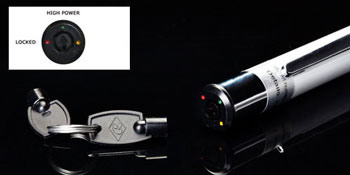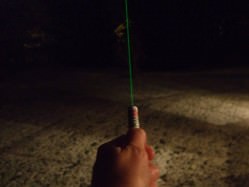Have you ever been blown away by a laser? I just was! The folks at SKYlasers sent us a 55 mW Green Laser Pointer to try out. I’ve only ever used very small laser pointers before for indoor presentations, so I was completely unprepared for the power of this laser pointer. I literally felt like I could reach out and touch the Moon and stars!
This green laser pointer has a reported range of 80 km (50 miles.) The laser is easily visible in the day time too, well over 30 meters (100 feet,) — and likely even more — even in bright daylight, I discovered (see image at the bottom.)
SKYlaser laser pointers are about the size of a Sharpie pen. There is a clip to easily attach the laser pointer securely to a bag or shirt pocket (or pocket protector!) so it is easy to find when you’re outside and trying to point out a constellation or star to someone else.
These laser pointers are very easy to use: just put in 2 AAA batteries, push the button and the beam of light zooms out to space — well, not technically, since space is officially 100 km up – but SKYlasers has other higher powered laser pointers that actually do reach that threshold and beyond. But for all amateur or even professional astronomers wanting to point out any object in the night sky, this laser pointer will meet your needs. I’ve been at instructional astronomy viewing nights where the instructor’s laser pointer was difficult to see and it was hard to follow where the instructor was pointing. Not with this one! It produces a powerful beam that you can’t miss seeing!

The 55 mW green laser also has a key feature that can turn off the laser so it won’t turn on accidentally if the button gets pressed while in a pocket or bag. Other more powerful SKYlaser pointers have a key that can dim the beam, so if you do want to use it indoors, it won’t be over-powering.
The 55mW green laser I received retails for $129.99 USD, but SKYlasers has a whole range of green lasers from a 5mW at $39.99 to a 150mW at $299.99. Plus they have even more powerful red laser pointers and the super powerful infrared laser pointers. Some of these are so powerful that they even come with goggles. SKYlasers also has some portable lasers that are beyond what any average person or astronomer would need.

I would just like to point out that any of these laser pointers are not toys, so please treat them with all the necessary respect and safety precautions. They can sting skin and hurt your (or others) eyes. The 55 mW laser can burn through a black trashbag (yes, we actually tried this, and the bag started melting in about 15 seconds). Some of the more powerful ones can light matches, burn dark fabrics, etch dark plastics and leathers, light fireworks, or even melt rubber and plastics. Not sure why you’d want to do some of these things, but it points out how powerful they are. Of course, you also need to watch out for planes in the area when you are using them. If you are doing an astronomy activity with a large group where you might be easily distracted, I’d suggest appointing a “spotter” to keep on the lookout for airplanes that might come into the region.
But the SKYlaser green pointer is a great way to be able to share your love of astronomy with your friends and family. It would be a great gift for any astronomy buff.
For more information see the SKYlaser website.


Nancy’s got SNOW! Thanks for this info.! This laser looks like it would be a great addition to any star party.
I bought a cheapo chinesean laser at a flea market several years ago. It uses hearing aid batteries which are really expensive and they don’t last very long. The beam is not very powerful and the only thing I’ve been able to use it for is to drive my cat nuts. He’ll chase the little red dot around until he drops! No worries about him looking into the beam.. he won’t take his eyes off that lil dot! LOL!
I’m all in favor of science toys, and I am definitely a risk taker, but I am very unhappy about the way these lasers are marketed.
This review is dripping with testosterone, and the safety disclaimer is minimal and buried way too deep in the article.
Being advertised this way, it will be bought by someone who is not educated enough to prevent injury, and someone will be blinded.
The fact that the makers are marketing these in irresponsible ways is one thing – it’s the way of the world, I guess. As someone who is more knowledgeable, I would have passed on this endorsement.
In this case I even feel obliged to post this comment with the hope that it will prevent a few accidents. This is especially true since in this case the injury is likely to be permanent, and involve someone else’s eyesight. Retinas don’t grow back like skin does.
I’ve used a 100mW green laser for some excitation work, but it sound as though I was lucky not to get hurt or blind in the process. (This was a model that had to be plugged in.)
The paragraph warning about the lasers is a very convincing argument against these lasers in civilian use. Heck, even the phrase “it’s all fun and games until someone looses an eye” is literally true!
I definitely think they are cool! And understand the excitement. But they are not toys and should be treated that way. The fact that they are green where the eyes are most sensitive and have a higher photon energy than standard red laseres should be a warning sign.
We have a 15W green laser in the lab. I have never thought about how far into space it should shoot. 🙂
I’ve got a green laser as well, and I treat it with the same care and safety as if it’s a loaded gun in my house. That said, it’s the most amazing tool for astronomy.
No offence intended, but I didn’t find this ‘review’ all too helpful. I can find all the specs mentioned here from the company’s website. It would be very instructive to detail how this thing performs in the real world. How long do the batteries last? Does it do well in the cold? How far from the ‘instructor’ must one be to see this beam? How stiff is the button? …etc.
So what you are saying is, Nancy has validated the claims of the website?
I find this fact very helpful. It is a pitty you do not.
Thanks Nancy!
I agree with the safety concerns expressed in the comments.
Most people will know pointing at eyes is dangerous, but in this range of power, the mere instant reflection on a shiny surface during indoors use can be damaging to the user’s eyes. It happens.
These things are not for sale where I live, and however I’d love to have one, I’m thankful for that.
Aodhhan – there’s a difference between validating claims and repeating marketing slogans with feverish enthusiasm and in a first person narrative.
The difference between these and guns is that guns look dangerous, they create obvious damage when used on targets, and are not marketed as toys. The lasers look friendly and don’t give any indication of their potential harm until after the harm is done.
They are accidents waiting to happen, and while pointing out stars to your friends is a nice application for them, in this case I think it is irresponsible to promote them this way.
They should be available for sale, in science stores, in astronomy stores even, but marketed for that purpose. Instead they are promoted like skateboards.
The barrier to shining the beam in someone’s face is infinitely lower then, for example, shooting them with a BB gun. A 10 year old will do it in the living room without thinking twice.
K – I’m definitely repeating myself here. I strongly recommend that you do not buy them as fun toys for your family.
I think the clue to the variety of responses to Nancy’s review lies in her first sentence. She states that she had never used a laser more powerful than we use in the lecture room.
I use a 5mw green laser of good quality and it works well, “only” goes 1000 metres but that is far enough. The 55mw version is too powerful for the untrained hand.
When we used powerful lasers in the lab, all but nonessential workers had to leave the room.
Tammy has reviewed a normal green laser in UT 27/09/08, it was, dare I say it, a Celestron Product.